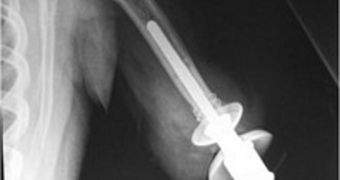Experts around the world are currently engaged in a research effort to determine better methods of installing prosthetics in their patients, while at the same time eliminating the risks of infection and rejection.
Techniques to do so already exist, but they are dangerous. When a metal rod is inserted into the hand, for example, is protrudes through the skin to form the receptacle for a prosthetic arm. But this exposes the point of contact to contaminations and infections.
On the other hand, installing this type of prosthetics into patients is a lot better in securing an artificial arm or leg to the bones than simply attaching them on the outside of the skin. At this point however, the former's risks outweigh its benefits, and scientists want to change that.
Some people, for example, need to wear detachable prosthetic arms. In order to increase comfort, they take them off at night. To make the process simple, researchers install a large rod in the bones of the arm, and take its end out through the skin. Patients then use the rod to attach or detach the synthetic arm.
But today's technology does not allow for a seamless connection between bones, skin and metal, and so infections and secondary surgeries are fairly common with this type of implant, Technology Review reports.
Though in clinical trials for ten years, such prosthetics have not yet been completely integrated into the human body. A team of experts from the United States and the European Union is now taking the research effort further.
“We are very hopeful. The fact that folks who received the implants are ambulatory means that their quality of life is obviously much better than it was," explains the director of the Bioengineering Institute at the Worcester Polytechnic Institute, Grant McGimpsey.
“But we need to think about [infection risks] before implementing it in large numbers of people. We are looking for a prosthetic solution that will last 70 years,” he goes on to say.
Other scientists say that the new devices are needed because some amputees cannot walk or move with today's prosthetics. “Overwhelmingly, the biggest reason people can't walk after amputation is because they can't wear a socket,"” says University of Pittsburgh orthopedic surgeon.Richard McGough.
By discovering better methods of attaching osseointegrated implants, researchers could help improve the quality of life of many people who are lacking one or more limbs.

 14 DAY TRIAL //
14 DAY TRIAL //